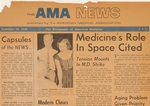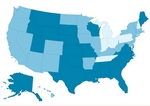business
Pace of mergers, acquisitions revs up for physician practices
■ An industry report finds health system reform driving consolidation among those who deliver care.
By Emily Berry — Posted Aug. 1, 2011
- WITH THIS STORY:
- » Health care deals
- » Correction
- » Related content
Physician practices are the fastest-growing segment of health care mergers and acquisitions, based on year-over-year growth in the number of transactions, according to a report by Irving Levin Associates, a Norwalk, Conn.-based health care publishing firm.
In the second quarter of 2011, Irving Levin counted 27 mergers and acquisitions, worth $416 million, involving physician practices. That was up 200% from the nine deals Irving Levin counted in the second quarter of 2010, after the Patient Protection and Affordable Care Act was passed.
If the number of practices sold seems small, and the average amount ($15.4 million) paid for each practice large, it's because Irving Levin counts only larger deals that are announced publicly. Still, the firm said the numbers reflect how health system reform is driving consolidation among those who deliver care. The number of hospital mergers and acquisitions grew 78% from the second quarter of 2010 to the same quarter of 2011, 18 to 32, according to Irving Levin.
"Hospitals continue to digest the new health care reform law and to wrestle with its implications," said Stephen M. Monroe, managing editor at Irving Levin, publisher of The Health Care M&A Report. "One conclusion they have drawn is, come what may, there is strength in numbers. Accordingly, they are buying other hospitals and physician medical groups to build up local and regional systems, implement ACOs -- accountable care organizations -- and share financial risk and reward through a more diversified provider network."
Physician practice purchases were highest 14 or 15 years ago, when the physician practice management industry was peaking, said Stanford Steever, editor of the report.
"Until recently, [activity] has been sort of lethargic," he said. "With the passage of the Affordable Care Act, we're starting to see a certain uptick of physician practice activity."
He said he expects to see more activity driven by ACOs, which can get bonuses under Medicare for delivering quality care while saving money.
Physicians and hospitals don't have to be under the same corporate umbrella to join together in ACOs, though analysts say ACOs are driving consolidation to make it easier for participating organizations to manage them and not run afoul of any possible antitrust issues.
Although Irving Levin doesn't break out ACO-only deals, there are indications that companies supplying services to ACOs are more active targets for investment or acquisition. For example, Essence Group Holdings Corp. recently received a $61 million investment from Camden Partners Holdings and Kleiner Perkins Caufield & Byers in large part because of its Lumeris division, which provides software to ACOs. Kleiner Perkins is a legendary Silicon Valley venture capital group that invested in the early stages of Sun Microsystems, Amazon.com and Google. (See correction)
"There is a feeling that the bigger the better -- that scale will give you more leverage," he said. "That's one reason I think ACOs, or the ACO-like phenomenon, will accelerate provider consolidation: Size is important in an era of change," said Christopher Kersey, MD, a partner at Camden.
Consolidation in the health industry
Overall, Irving Levin tallied $73.5 billion spent in 243 mergers and acquisition deals in health care from April through June, compared with 229 deals that happened during the previous three months and 233 during the second quarter of 2010. At the current pace, Irving Levin said, 2011 will set a health care mergers and acquisitions record, with about 950 deals worth $250 billion.
The most active sectors, by number of deals, were long-term care (38), followed by medical devices (36), hospitals and pharmaceutical companies (each with 32) and physician practices (27). Medical devices ($33.1 billion) and pharmaceuticals ($27.4 billion) dominated in terms of cash value of deals, making up 82% of the dollar amount, though only 28% of the deals.
The volume is not all driven by health system reform and the 30 million extra insured it's expected to provide by 2014.
"Most corporations have been cutting costs and making sure they are viable and surviving the [economic] downturn," Dr. Kersey said. "Considering that they're looking to grow, the highest-yielding growth avenues are just outright purchases."












